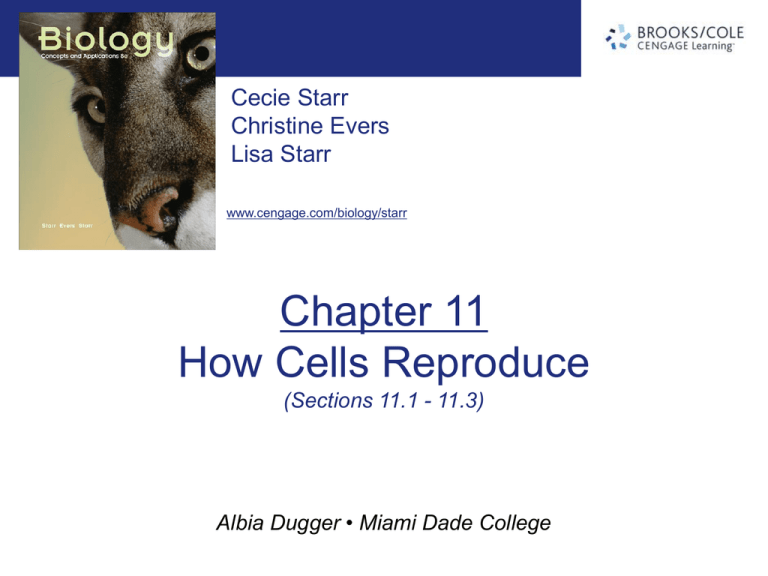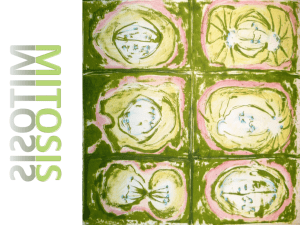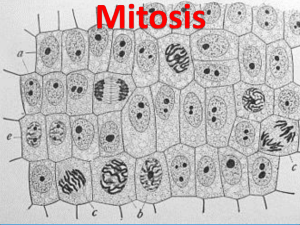
Cecie Starr
Christine Evers
Lisa Starr
www.cengage.com/biology/starr
Chapter 11
How Cells Reproduce
(Sections 11.1 - 11.3)
Albia Dugger • Miami Dade College
11.1 Henrietta’s Immortal Cells
• Henrietta Lacks died of
cancer at age 31
• 50 years later, her cells
still live in laboratories
around the world
• Most human cells grown
in laboratories die within
a few weeks
11.2 Multiplication by Division
• Cells reproduce by dividing
• Division of a eukaryotic cell typically occurs in two steps:
nuclear division followed by cytoplasmic division
• The sequence of stages through which a cell passes during
its lifetime is called the cell cycle
The Life of a Cell
• One cell cycle consists of three phases: interphase, mitosis,
and cytoplasmic (cell) division
• cell cycle
• A series of events from the time a cell forms until its
cytoplasm divides
Eukaryotic Cell Cycle
Eukaryotic Cell Cycle
1 G1 is the interval of growth before DNA
replication. The cell’s chromosomes
are unduplicated during
this stage.
2 S is the time of synthesis. The name
refers to DNA synthesis, because
the cell copies its DNA
during this
Stage.
6 At the
end of
mitosis,
the cytoplasm
typically divides,
and the cycle begins
anew in interphase for
each descendant cell.
3 G2 is the
interval after
DNA replication
and before mitosis.
The cell prepares to
divide during this stage.
5
The nucleus divides during mitosis.
4
Interphase ends.
Fig. 11.2, p. 164
ANIMATION: The cell cycle
To play movie you must be in Slide Show Mode
PC Users: Please wait for content to load, then click to play
Mac Users: CLICK HERE
Introduction to Interphase
• A typical cell spends most of its life in interphase
• interphase
• Interval between mitotic divisions when a cell grows,
doubles the number of its cytoplasmic components, and
replicates its DNA in preparation for division
• Consists of three stages: G1, S, and G2
Three Stages of Interphase
• G1: The first interval (or gap) of cell growth
• The time before DNA replication when cells engage in
their metabolic business
• S: The time of synthesis (DNA replication) when the cell
prepares to divide
• G2: The second interval (or gap) when the cell makes
proteins that will drive cell division
Introduction to Mitosis
• The nucleus divides during mitosis, producing an identical
copy of its set of chromosomes
• mitosis
• Nuclear division mechanism that maintains the
chromosome number
• Basis of body growth and tissue repair in multicelled
eukaryotes; also asexual reproduction in some plants,
animals, fungi, and protists
Homologous Chromosomes
• Human diploid cells have two sets of chromosomes: 46
chromosomes in 23 pairs
• Except for a pairing of sex chromosomes (XY) in males, the
chromosomes of each pair are homologous
• homologous chromosomes
• Chromosomes with the same length, shape, and set of
genes
Introduction to
Cytoplasmic Division
• When the cytoplasm divides, the new nuclei produced by
mitosis are packaged into separate cells
• Each new cell has a full complement of unduplicated
chromosomes, and each starts the cell cycle over again in G1
of interphase
Mitosis Maintains Chromosome Number
Mitosis Maintains Chromosome Number
A An unduplicated pair of
chromosomes in a cell in G1.
B By G2, each chromosome
has been duplicated.
C Mitosis and cytoplasmic division package
one copy of each
chromosome into each
of two new cells.
Fig. 11.3, p. 165
Mitosis Maintains Chromosome Number
A An unduplicated pair of
chromosomes in a cell in G1.
B By G2, each chromosome
has been duplicated.
C Mitosis and cytoplasmic division package
one copy of each
chromosome into each
of two new cells.
Stepped Art
Fig. 11.3, p. 165
A Bigger Picture of Cell Division
• Mitosis and cytoplasmic division increase body size during
development and replace damaged or dead cells
• Many species of plants, animals, fungi, and protists reproduce
by asexual reproduction using mitosis and cytoplasmic
division
• asexual reproduction
• Reproductive mode by which offspring arise from a single
parent only
Cell Division and Development
• Frog embryos after three mitotic divisions of a fertilized egg
Key Concepts
• The Cell Cycle
• A cell cycle starts when a new cell forms by division of a
parent cell, and ends when the cell completes its own
division
• A typical cell cycle proceeds through intervals of
interphase, mitosis, and cytoplasmic division
11.3 Mitosis
• During interphase, a
chromosomes are
loosened to allow
transcription and DNA
replication
• When mitosis begins,
duplicated DNA packs
tightly together into
chromosome shapes
The Four Stages of Mitosis
1. prophase
• Stage of mitosis during which chromosomes condense
and become attached to a newly forming spindle
2. metaphase
• Stage of mitosis at which the cell’s chromosomes are
aligned midway between poles of the spindle
The Four Stages of Mitosis
3. anaphase
• Stage of mitosis during which sister chromatids separate
and move to opposite spindle poles
4. telophase
• Stage of mitosis during which chromosomes arrive at the
spindle poles and decondense, and new nuclei form
Centrosomes and Spindles
• Most animal cells have a centrosome, a region with two
centrioles that gets duplicated just before prophase
• During prophase, one of the two centrosomes moves to the
opposite side of the cell, and microtubules extend from both
centrosomes to form a spindle
• spindle
• Dynamically assembled and disassembled network of
microtubules that moves chromosomes during nuclear
division
Mitosis: Prophase
• Early Prophase
• Mitosis begins: DNA starts to condense
• The centrosome gets duplicated
• Prophase
• Duplicated chromosomes become visible
• One of the two centrosomes moves to the opposite side of
the nucleus
• The nuclear envelope breaks up
Mitosis: Prophase
• Early prophase
• Prophase
Mitosis: Metaphase
• Transition to Metaphase
• Nuclear envelope is gone; chromosomes are at their most
condensed
• Spindle microtubules assemble and bind to chromosomes
at the centromere
• Sister chromatids are attached to opposite spindle poles
• Metaphase
• Chromosomes are aligned midway between spindle poles
Mitosis: Metaphase
• Transition to Metaphase
• Metaphase
Mitosis: Anaphase and Telophase
• Anaphase
• Spindle microtubules separate the sister chromatids and
move them toward opposite spindle poles
• Each sister chromatid is now an individual, unduplicated
chromosome
• Telophase
• Chromosomes reach the spindle poles and decondense
• A nuclear envelope forms around each cluster, and mitosis
ends
Mitosis: Anaphase and Telophase
• Anaphase
• Telophase
Mitosis: Prophase
Fig. 11.5.1-3, p. 167
Mitosis: Prophase
centrosome
1 Early Prophase
Mitosis begins. In the nucleus,
the DNA begins to appear
grainy as it starts to condense.
The centrosome gets duplicated.
2 Prophase
The duplicated chromosomes
become visible as they condense.
One of the two centrosomes
moves to the oppositeside of the
nucleus.
The nuclear envelope breaks up.
3 Transition to Metaphase
The nuclear envelope is gone,
and the chromosomes are at
their most condensed. Spindle
microtubules assemble and
bind to chromosomes at the
centromere. Sister chromatids
are attached to opposite spindle
microtubule of spindle
poles.
Fig. 11.5.1-3, p. 167
Mitosis: Prophase
Fig. 11.5.4-6, p. 167
Mitosis: Prophase
4 Metaphase
All of the chromosomes are
aligned midway between the
spindle poles.
5 Anaphase
Spindle microtubules separate
the sister chromatids and move
them toward opposite spindle
poles. Each sister chromatid
has now become an individual,
unduplicated chromosome.
6 Telophase
The chromosomes reach the
spindle poles and
decondense. A nuclear
envelope forms around each
cluster, and mitosis ends.
Fig. 11.5.4-6, p. 167
Animation: Mitosis
Animation: Mitosis
Key Concepts
• Mitosis
• Mitosis divides the nucleus and maintains the
chromosome number
• It has four sequential stages: prophase, metaphase,
anaphase, and telophase
• A spindle parcels the cell’s duplicated chromosomes into
two nuclei
ANIMATION: Mitosis-Step-by-Step
To play movie you must be in Slide Show Mode
PC Users: Please wait for content to load, then click to play
Mac Users: CLICK HERE
ANIMATION: Chromosome choreography
To play movie you must be in Slide Show Mode
PC Users: Please wait for content to load, then click to play
Mac Users: CLICK HERE










